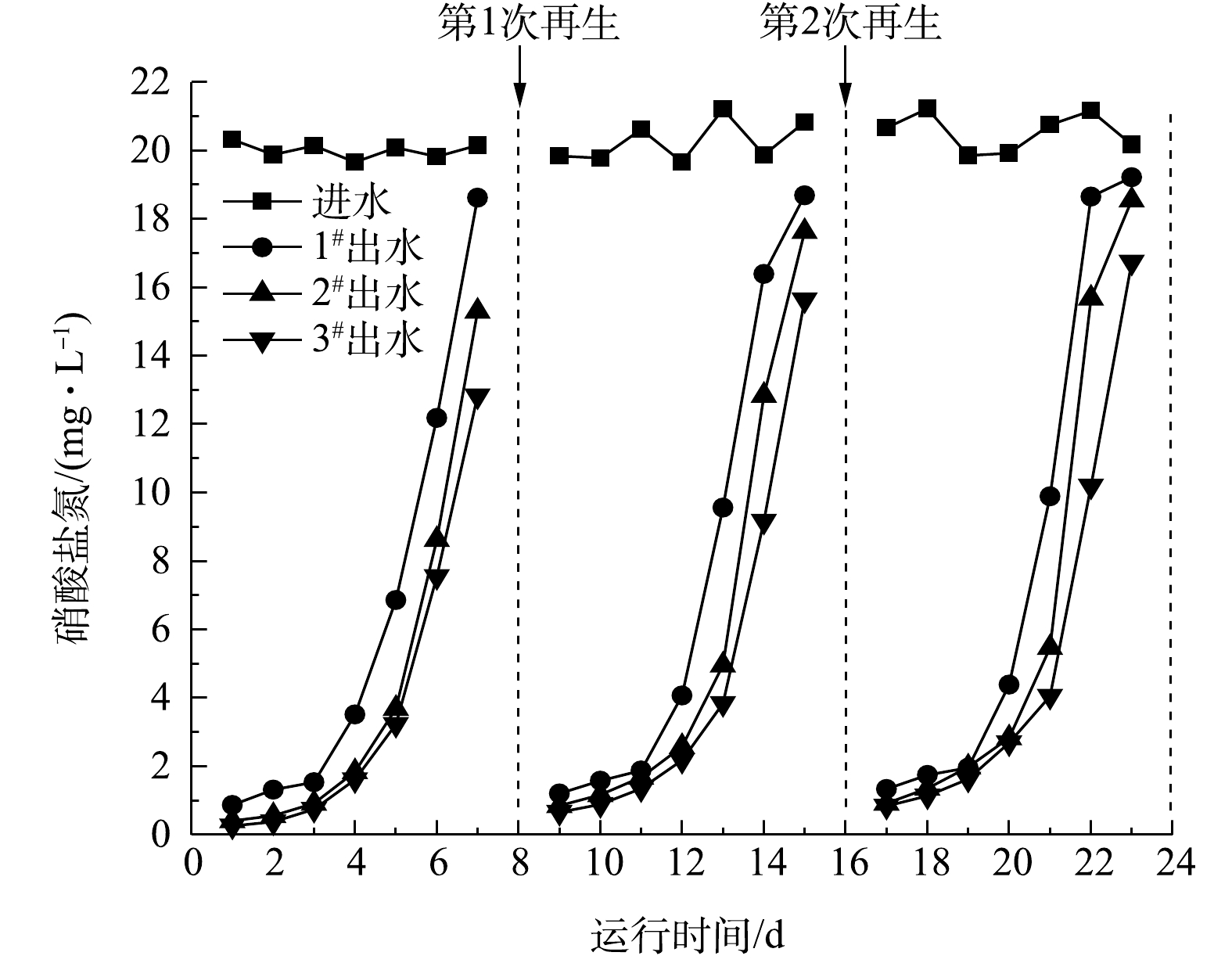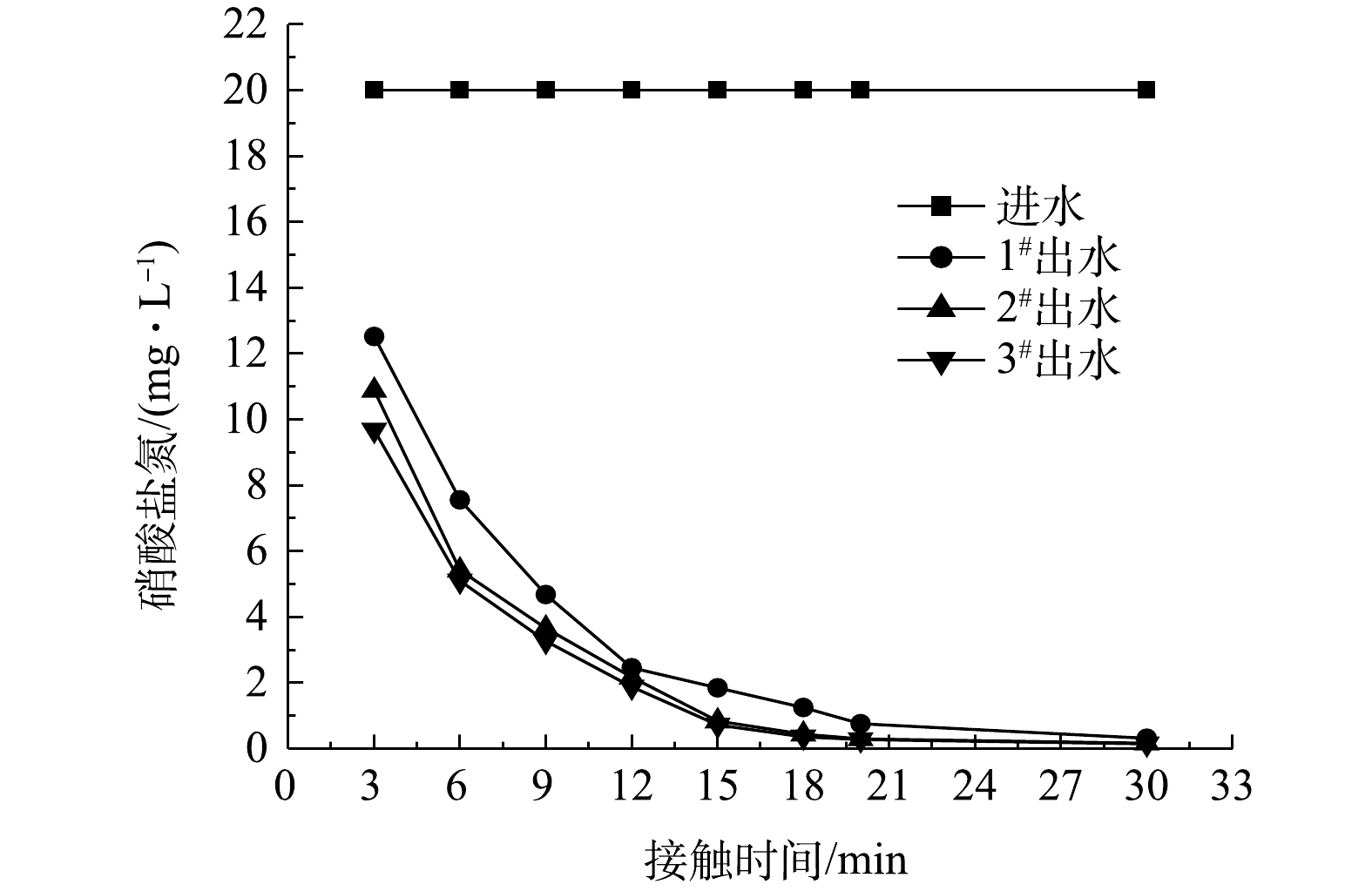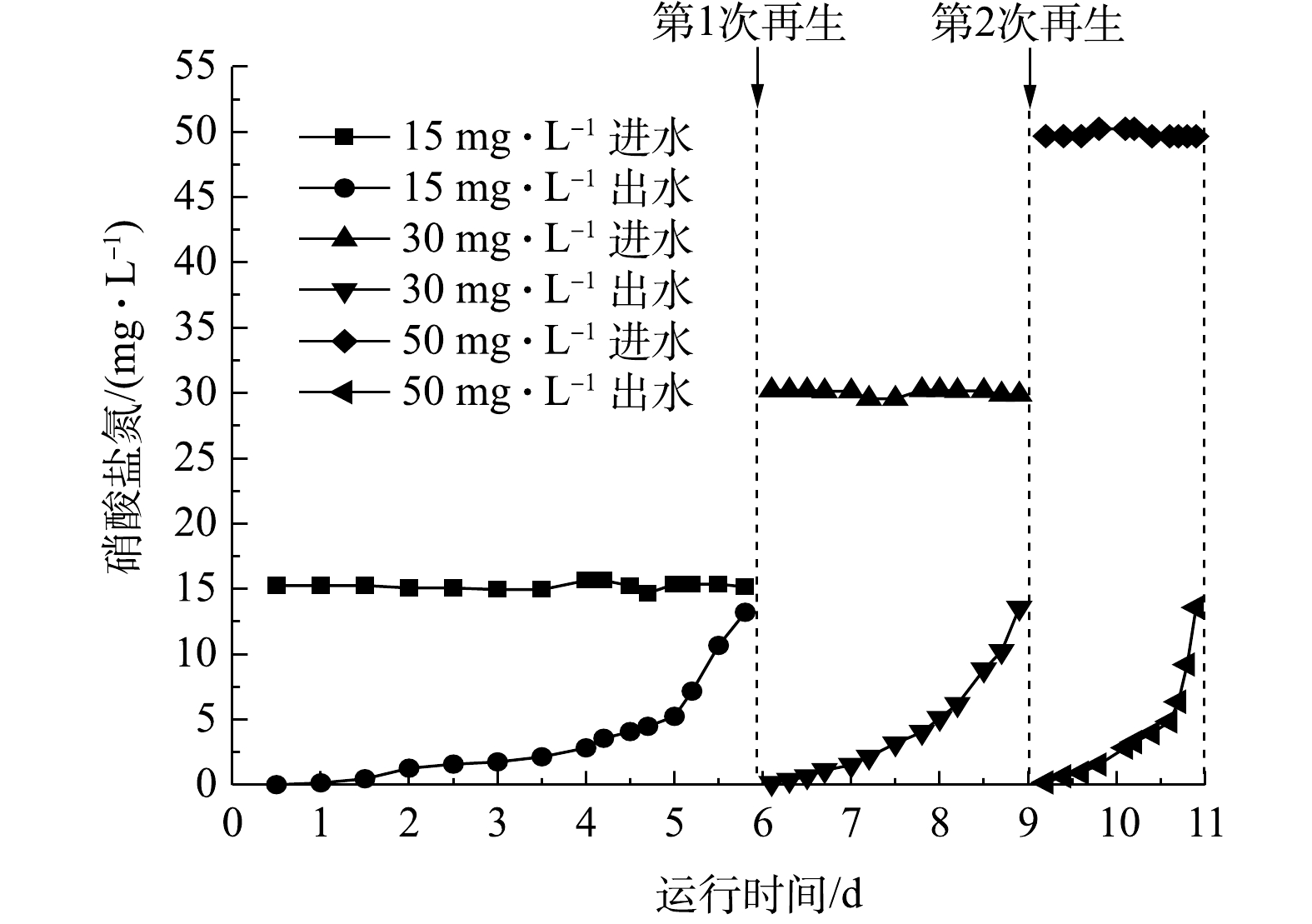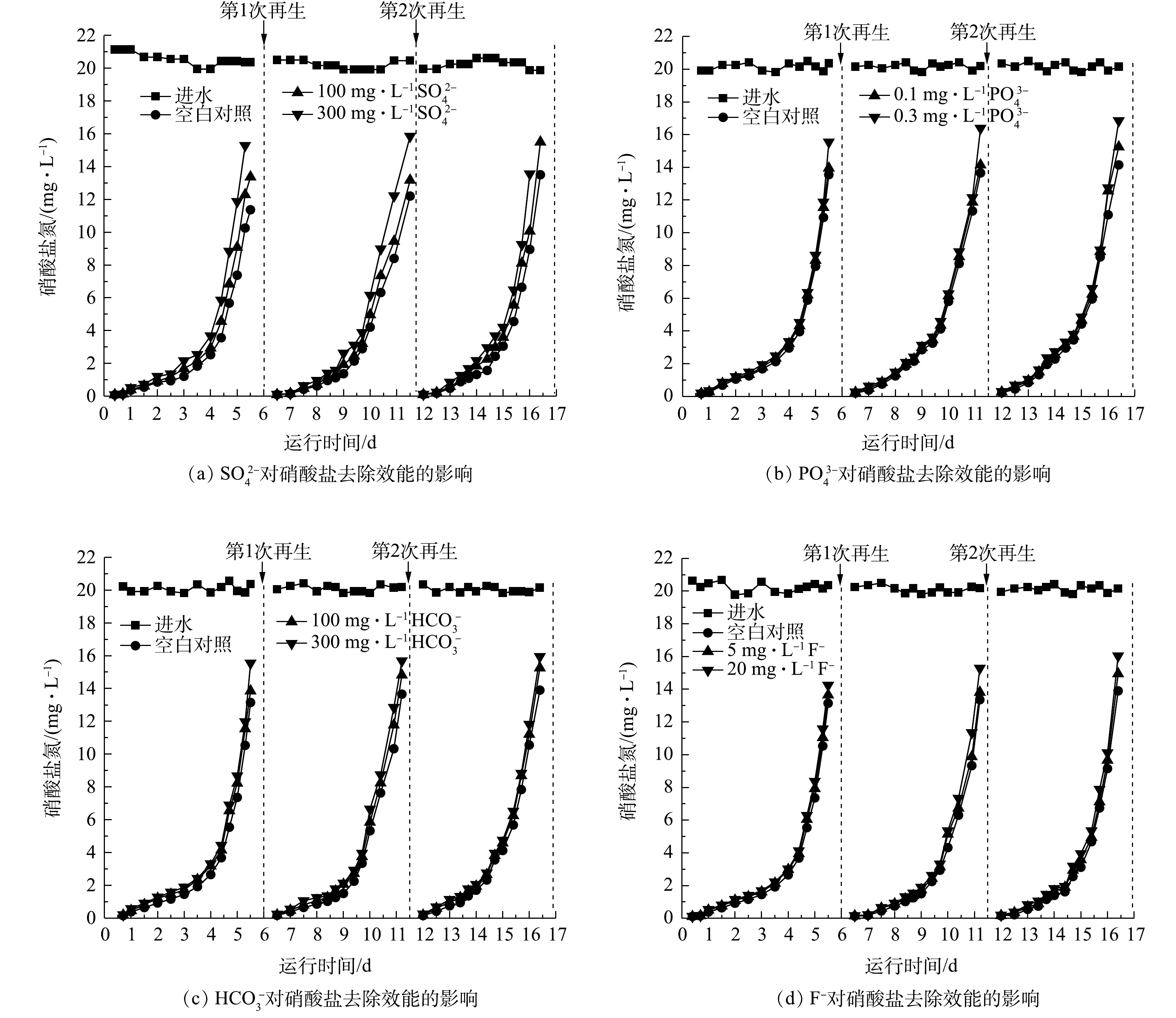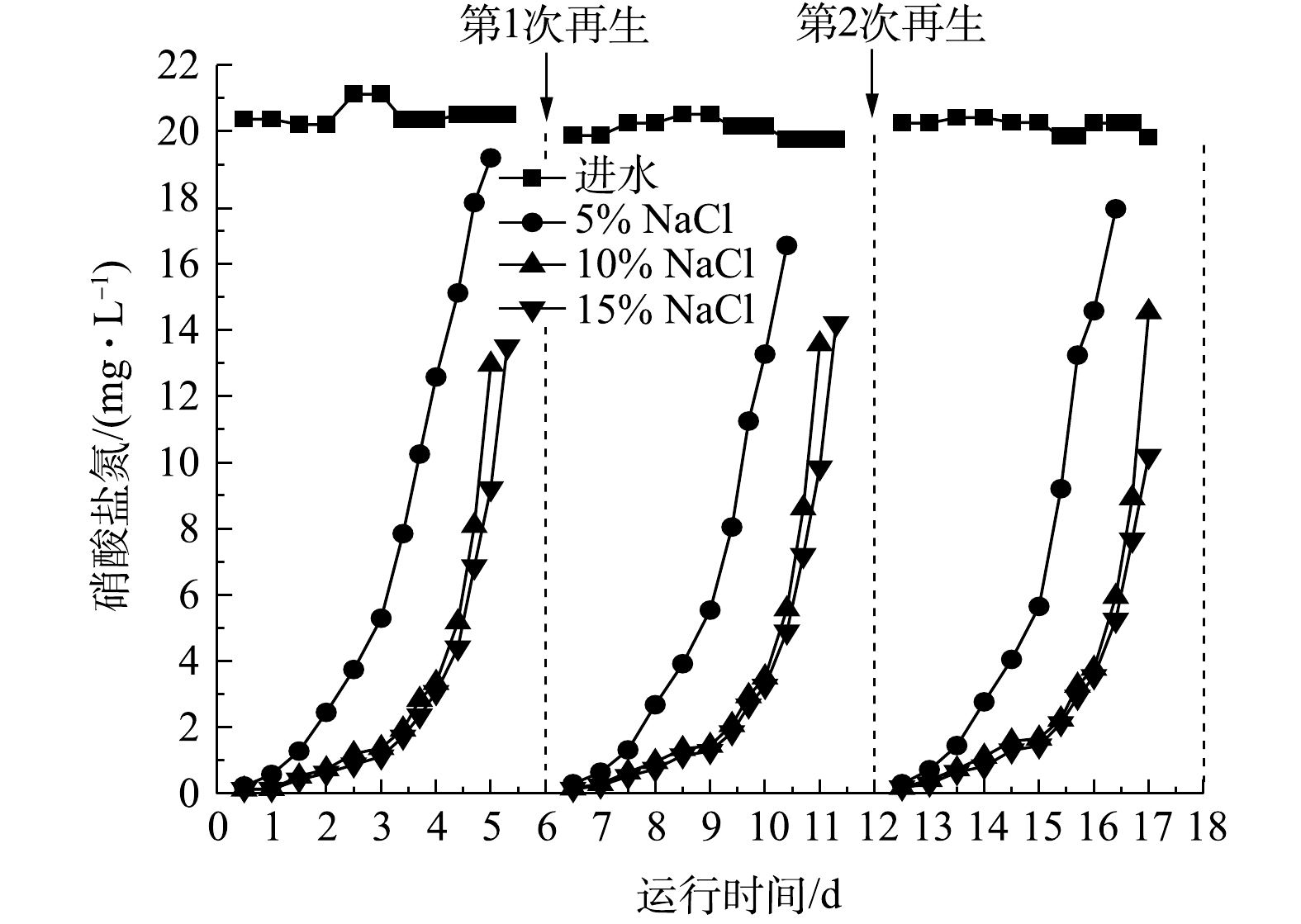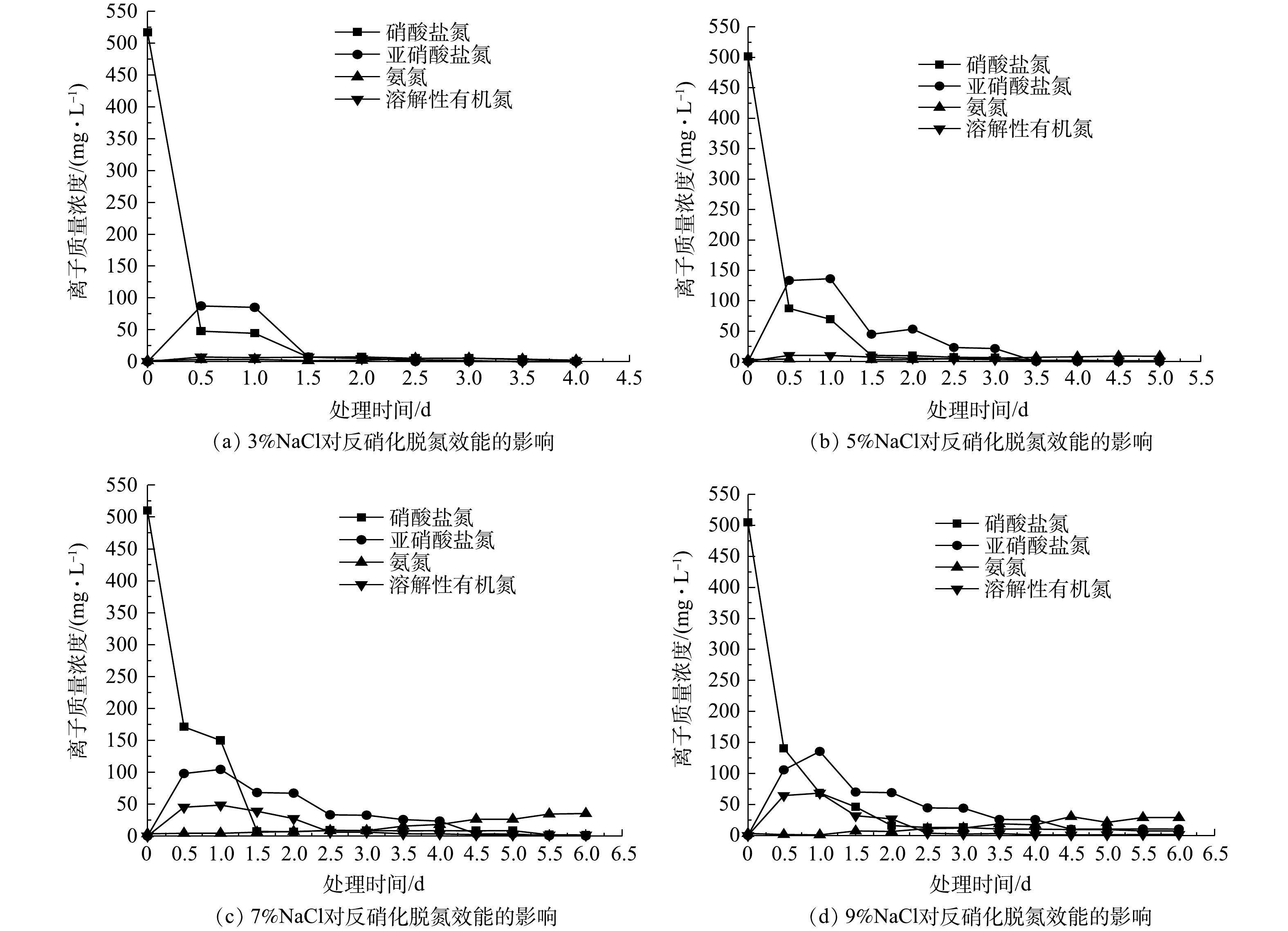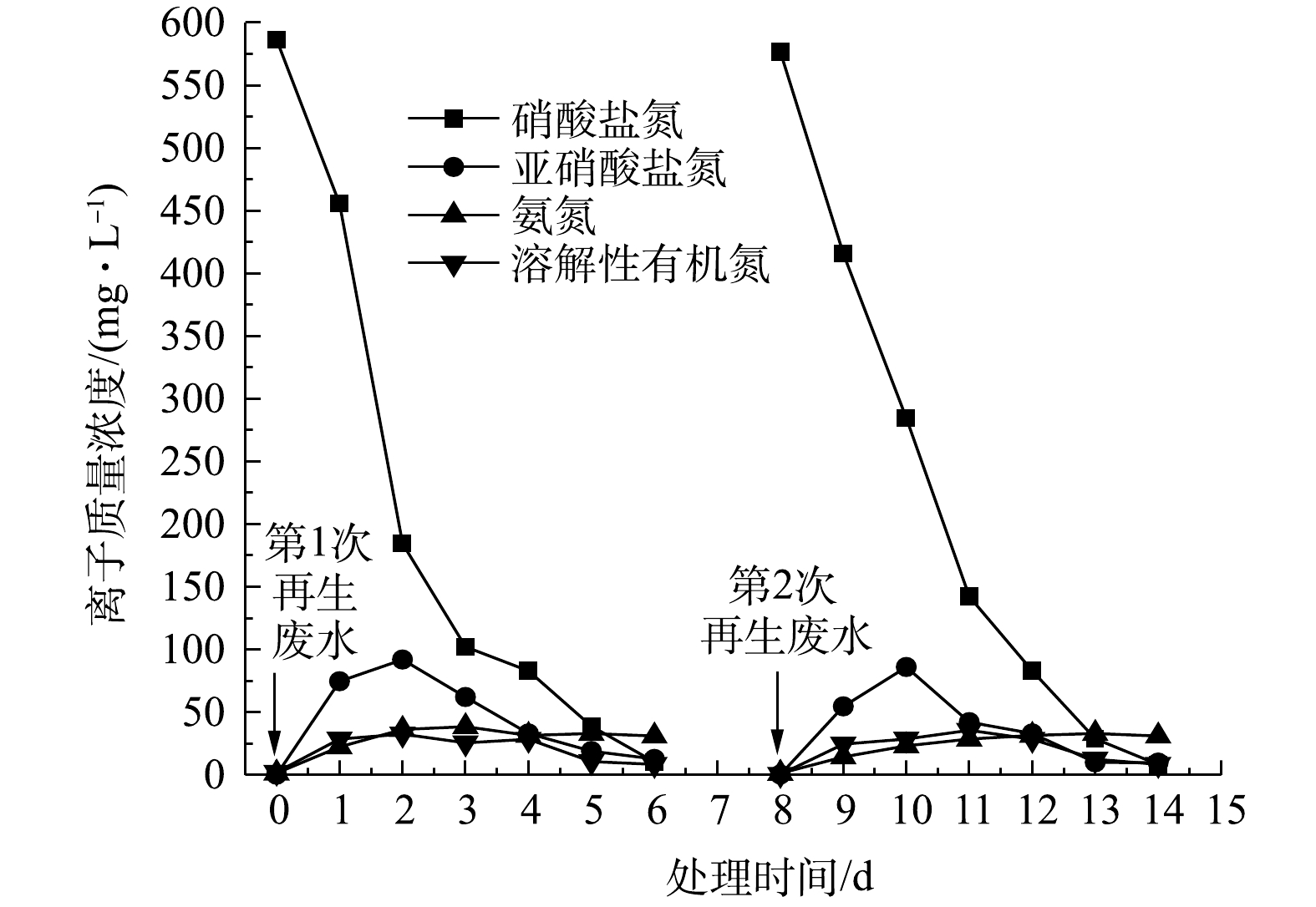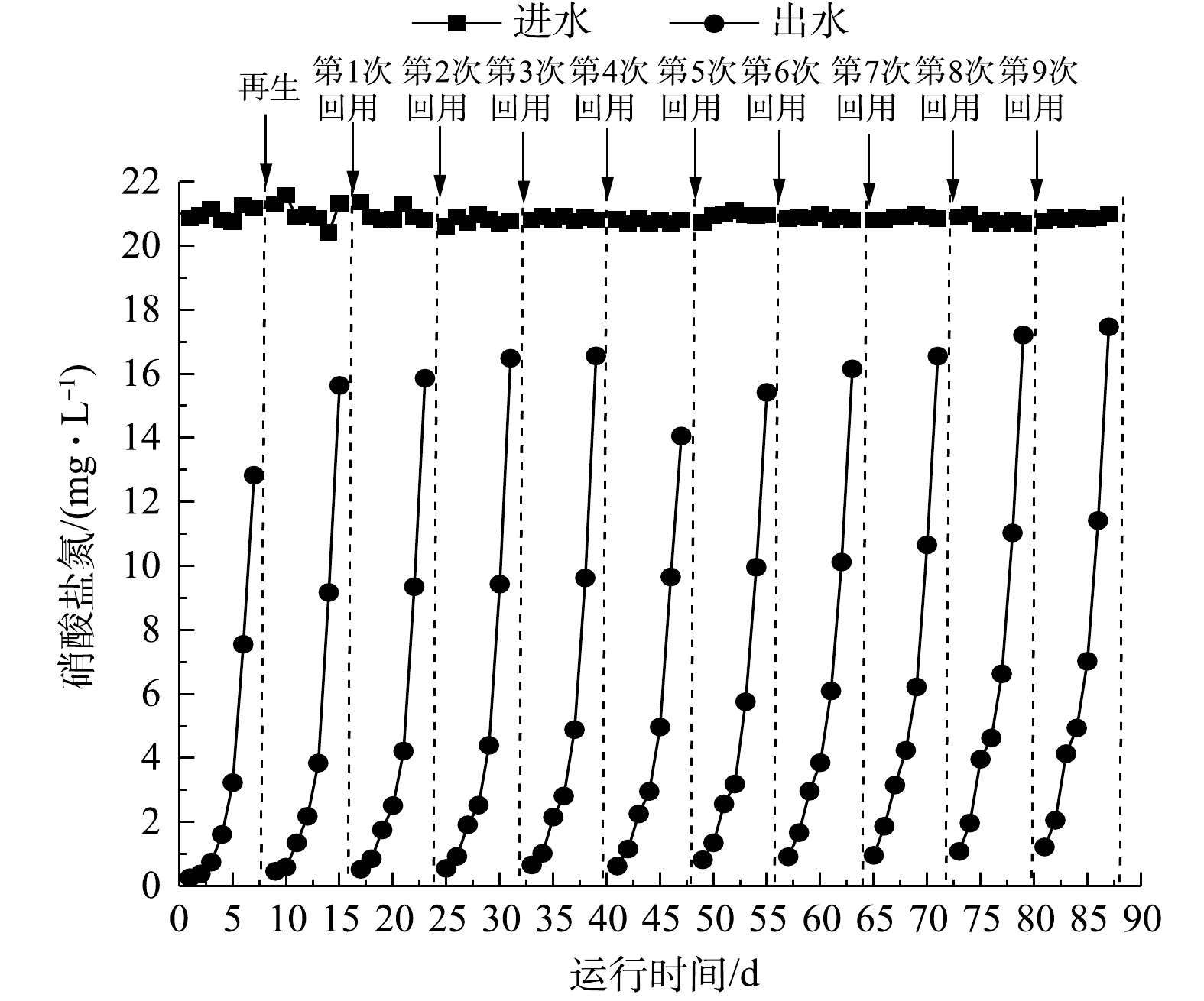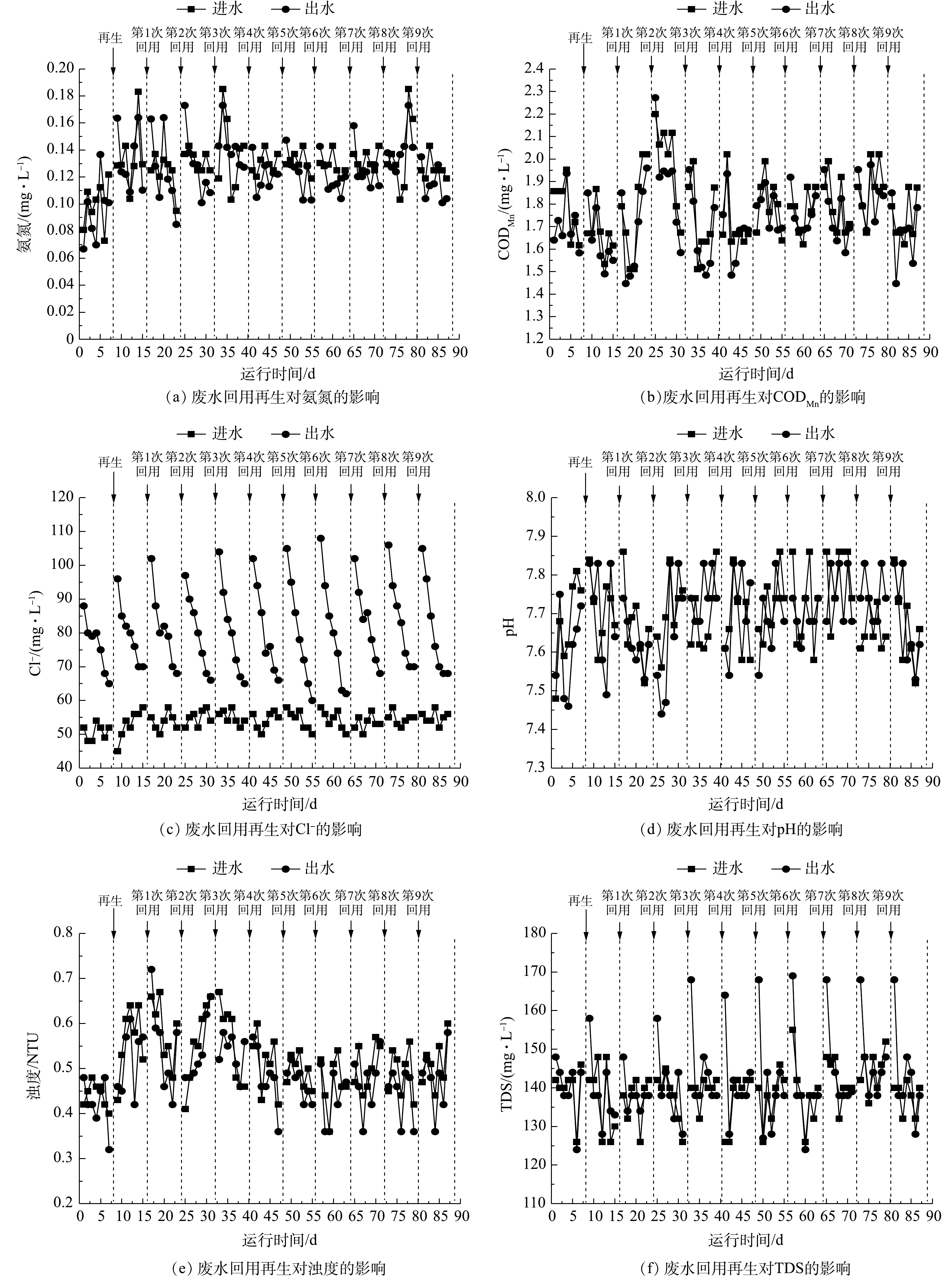-
硝酸盐是饮用水中常见污染物之一。一般认为,饮用水中的硝酸盐本身对人体毒性很小,但在肠胃内容易被还原为亚硝酸盐和亚硝基化合物,而亚硝酸盐毒性是硝酸盐的11倍,会对人体健康造成严重威胁,尤其对婴幼儿的危害更大,亚硝基化合物会诱导肠道、胃、脑、神经系统、骨骼、皮肤、甲状腺等发生肿瘤疾病[1-2]。目前饮用水中硝酸盐去除技术主要有反渗透[3-4]、离子交换[5-11]、电渗析[12]、生物反硝化[13]等,但在实际应用中也存在一定的问题。为克服单一技术的缺点,组合工艺越来越受到国内外学者的关注[1,14]。
离子交换因其硝酸盐去除率高、去除速度快、树脂可重复使用、投资和运行费用相对较低等优点受到广泛的关注,其比较适合于中小型水厂。但常规树脂选择性较差、易受硫酸根等阴离子干扰、再生废水难以处置等缺点限制了其在实际工程中的应用,其中,再生废水的安全合理处置是关键。生物膜反硝化法具有挂膜速度快、脱氮效率高、适应性强等优点,可以用于树脂再生废水的生物处理。近年来,国内外关于离子交换结合生物脱氮或电化学催化组合工艺已有较多研究[15-18],但其处理效能、工艺组成、优化工艺参数尚需进一步确定。因此,本研究在使用离子交换法去除硝酸盐的基础上,利用生物膜反硝化法处理树脂再生废水,提出了离子交换和生物脱氮组合工艺,考察了其对饮用水硝酸盐去除及再生废水循环利用的可行性,并进行了相关工艺参数优化,以期为减少树脂再生盐耗、减少环境污染、降低水厂处理成本提供参考。
全文HTML
-
1)离子交换树脂。针对离子交换去除饮用水中硝酸盐,在选择树脂类型时可以考虑以下原则。一是树脂要有一定的选择性。选择性越强,树脂和水中的硝酸根离子键合强度越强,越不容易发生硝酸盐的解析,但树脂选择性过强,也可能导致再生过程中盐耗和再生时间的增加,所以在选择时既要考虑树脂的选择性能,又要方便树脂再生。二是具有较大的吸附容量。吸附容量的大小直接影响着对硝酸盐的处理效果和树脂再生周期,在相同条件下要尽可能选择吸附容量大的树脂。三是要有适宜的溶胀性。树脂溶胀性越好,其渗透能力越强,对硝酸盐的去除速率越快,但也可能会影响树脂的机械强度,溶胀性越高,树脂越容易破损。四是价格合理且使用寿命长。价格和使用寿命是树脂能否在实际应用中的重要考虑因素。由于上述原因,在选择树脂类型时,应该以高的硝酸盐选择性和吸附容量为基本,同时兼顾溶胀性、价格和使用寿命。根据以上树脂选型原则,考虑处理效能、再生条件、安全环保等因素,从市面上初步优选了3种硝酸盐选择性树脂(编号1#、2#、3#)开展实验,3种树脂基本物化指标如表1所示。实验用水为河海大学实验室市政自来水,其水源为长江水,典型水质特征为:1.0~1.5 mg·L−1 硝酸盐氮、0.05~0.1 mg·L−1 亚硝酸盐氮、0.05~0.2 mg·L−1 氨氮、1.5~2.5 mg·L−1 CODMn、50~60 mg·L−1 氯离子、100~120 mg·L−1 硫酸根离子、150~180 mg·L−1 总硬度(以CaCO3计)、0.04~0.1 mg·L−1 氟离子、0.05~0.08 mg·L−1 磷酸根离子、100~120 mg·L−1 碳酸氢根离子、130~150 mg·L−1 总溶解性固体。向自来水中加入硝酸钠配制高硝酸盐原水,控制硝酸盐氮质量浓度19~22 mg·L−1。
2)所需药剂。实验所需药剂主要有硝酸钠、氯化铵、无水葡萄糖、磷酸二氢钾、盐酸、硫酸、磷酸、氢氧化钠、纳氏试剂、酒石酸钾钠、N-(1-奈基)-乙二胺盐酸盐、对氨基苯磺酰胺、氨基磺酸、重铬酸钾、硫酸银、氯化钠、氟化钠、碳酸氢钠等,所有药剂均为分析纯。
-
1)离子交换小试装置。本研究搭建3根离子交换小试装置,材质为有机玻璃,结构如图1所示。装置分为树脂吸附单元、树脂再生单元。离子交换柱内径4 cm,高40 cm,填料从下往上依次为砾石(粒径5~8 mm)5 cm、石英砂(粒径0.8~1.2 mm)5 cm、树脂20 cm。装置底部中心进水,上部出水,并在底部和上部设置1层100目的滤布,防止树脂流失。
2)再生废水处理装置。搭建6根再生废水处理小试装置,材质为有机玻璃,内径4 cm,高150 cm。采用培养驯化的生物膜反硝化系统处理树脂再生废水,填料从下往上依次为:砾石(粒径5~8 mm)10 cm、石英砂(粒径0.8~1.2 mm)10 cm、活性炭100 cm,其中活性炭采用椰壳颗粒炭,碘值500~600 mg·g−1,粒径3~8目。
-
1)离子交换小试实验吸附—再生实验。离子交换小试装置采用底部中心进水、上向流连续运行方式,收集上部出水定时检测分析。当出水硝酸盐氮质量浓度达到10 mg·L−1时,即认为树脂吸附饱和,树脂饱和后即进行再生。具体再生方式为:树脂柱排空;配制3倍树脂体积、质量分数10%的NaCl溶液;上向流进盐水再生,再生流量与进水流量相同;排空树脂柱内盐水;树脂反洗置换,反洗流量与进水流量相同,反洗至出水Cl−与进水相同时结束;树脂再生完成,投入运行。重点考察了接触时间、进水硝酸盐质量浓度、共存阴离子、再生液质量分数对硝酸盐处理及再生效能的影响。基于树脂的吸附性能、影响因素,明确了最佳的树脂类型及运行再生条件。
2)再生废水处理实验。树脂再生废水基本水质特征为高盐高硝酸盐,一般微生物难以存活。为提高微生物反硝化脱氮效果,缩短生物反硝化系统启动时间,通常需要接种微生物。可采用驯化活性污泥等淡水微生物、接种盐湖盐场等高盐环境下的污泥、直接添加嗜盐微生物或菌液制剂等。无论采取哪种方式,接种后都需要进行进一步的富集培养。其中,驯化活性污泥等淡水微生物是一种常用的方法。该方法具有原料易得、成本低、效果稳定等优点,但系统构建时间较长。接种盐场等高盐环境下活性污泥或嗜盐微生物能够快速、有效的构建出再生废水处理系统,但由于嗜盐菌的筛选、连续投加及稳定运行条件复杂,所需的成本也较高,故不利于再生废水处理的实际工程应用。因此,本研究采用接种活性污泥并缓慢提升盐度,进行长期的培养驯化,同时采用配水系统构建完成后再处理实际再生废水的方式,最大限度的保持系统的稳定性,提高处理效果。另外,在长期的培养驯化过程中,活性污泥中的有害成分会逐渐消失,不会对水质安全产生不利影响。
再生废水生物处理装置采用底部中心进水,上向流循环处理方式。装置启动与运行分为3个阶段:第1阶段为接种启动期,从南京江心洲污水处理厂取活性污泥进行反硝化细菌的接种富集,同时添加适量碳氮磷等微生物生长所需的营养物质,接种启动期约5 d;第2阶段为耐盐反硝化微生物培养期,根据设定条件,每次配制2 L不同质量分数的氯化钠和硝酸盐模拟废水,氯化钠质量分数从0逐渐提高至10%,硝酸盐氮质量浓度从0 mg·L−1逐渐提高至500 mg·L−1,每个浓度梯度处理周期5~7 d,连续运行2~3个周期,直至处理效果稳定,耐盐反硝化微生物培养成熟,耐盐反硝化微生物培养期约90 d;第3阶段为实际再生废水处理期,利用培养成熟的反硝化微生物处理树脂再生废水,再生废水处理后循环多次用于树脂再生。实验过程中温度控制在30 ℃左右,pH控制在6~9,根据每次配水硝酸盐氮浓度,按照C∶N∶P=50∶10∶1的比例添加营养物质。其中,碳源采用无水葡萄糖,磷源采用磷酸二氢钾,投加方式为配水时一次性投加。从第2阶段开始,每天测定出水中
${\rm{NO}}_3^ - $ -N、${\rm{NO}}_2^ - $ -N、${\rm{NH}}_4^ + $ -N、DON等指标。3)主要实验仪器及设备。实验仪器包括紫外-可见分光光度计(T6新世纪)、总溶解性固体测定仪(DDS-307A)、pH计(PHS-25)、浊度仪(2100P)、数控多功能消解仪(DIS-1A)、高压灭菌器(SYQ-DSX-280B)、恒温水浴锅(HH-6)、电子天平(AUY120)、蠕动泵(BT100-2J)。
4)主要检测指标及方法。本研究中,水样经0.45 μm滤膜过滤后,取上清液按标准方法检测,其中,
${\rm{NO}}_3^ - $ -N采用紫外分光光度法测定,${\rm{NO}}_2^ - $ -N采用N-(1-萘基)-乙二胺光度法测定,${\rm{NH}}_4^ + $ -N采用纳氏试剂分光光度法测定,CODMn采用酸性法测定,COD采用重铬酸钾法测定,Cl−采用硝酸银滴定法测定,${\rm{SO}}_4^{2 - }$ 采用光度法测定,碱度采用盐酸滴定法测定。每个样品均检测3次,结果取平均值,以保证实验数据的准确、可靠。
1.1. 实验材料
1.2. 实验装置
1.3. 实验方法
-
1)离子交换树脂优选。离子交换装置底部中心进水,收集上部出水并重点检测硝酸盐氮,树脂接触时间约20 min,当出水硝酸盐氮质量浓度达到10 mg·L−1时,即认为树脂吸附饱和。树脂饱和后,用3倍树脂体积的10% NaCl溶液进行再生。3种硝酸盐选择性树脂在相同条件下连续运行3个周期,结果如图2所示。图2表明,当进水硝酸盐氮质量浓度为20 mg·L−1,1#、2#、3#树脂分别运行至第6、7、7天时,出水硝酸盐氮达到12.2、15.3和12.8 mg·L−1,通水倍数分别为320、380和400 BV。在3个运行周期内,3种树脂再生效率分别为83%、88%和91%,其中3#树脂对硝酸盐的去除效果最好,且保持稳定。
2)接触时间对硝酸盐去除效能的影响。采用烧杯实验考察了接触时间对硝酸盐去除效能的影响。分别取3种新鲜树脂10 mL于1 L烧杯中,各加入1 L初始硝酸盐氮20 mg·L−1的自配水样,置于六联搅拌器下,转速200 r·min−1,反应温度约20 ℃,每隔3 min取样1次,结果见图3。在接触15 min之内,3种树脂处理后的出水硝酸盐氮随时间的延长显著降低,15 min时,2#和3#树脂出水硝酸盐氮降至1 mg·L−1以下;在15~20 min,出水硝酸盐氮进一步降低并趋于稳定,基本实现了硝酸盐的完全去除,其中2#和3#树脂对硝酸盐的去除效果优于1#。结合图2结果,可确定3#树脂为实验最佳树脂,故在后续实验中,均采用3#树脂,接触时间宜控制在15~20 min。
3)进水硝酸盐氮质量浓度对硝酸盐去除效能的影响。考察了3#树脂在进水硝酸盐氮质量浓度15、30、50 mg·L−1时,对硝酸盐的处理效能。当出水硝酸盐氮质量浓度达到10 mg·L−1时,认为树脂吸附饱和,随即对其进行再生,结果如图4所示。由图4可知,3#树脂对不同进水硝酸盐质量浓度均具有稳定的处理效果,出水硝酸盐氮的变化趋势相同,至饱和时通水倍数与进水硝酸盐氮浓度呈反比。经计算可知,树脂饱和时所吸附的硝酸盐氮基本相同,表明优选的树脂具有较强的抗冲击负荷能力。
4)共存阴离子对硝酸盐去除效能的影响。自然水体中存在多种阴离子,如
${\rm{SO}}_4^{2 - }$ 、${\rm{NO}}_3^ - $ 、Cl−、F−、${\rm{PO}}_4^{3 - }$ 、${\rm{CO}}_3^{2 - }$ 、${\rm{HCO}}_3^ - $ 、OH−等,可能会影响树脂对硝酸盐的去除效果,如常规除硝酸盐树脂对${\rm{SO}}_4^{2 - }$ 具有较强的吸附能力,对常见阴离子的吸附能力为${\rm{SO}}_4^{2 - }$ >${\rm{NO}}_3^ - $ >Cl−>${\rm{HCO}}_3^ - $ >OH−。如果原水中${\rm{SO}}_4^{2 - }$ 浓度过高,则树脂会优先吸附水中的${\rm{SO}}_4^{2 - }$ ,而降低对硝酸盐的去除效果,同时会造成再生废水中富集较多的${\rm{SO}}_4^{2 - }$ 。因此,有必要评估优选的硝酸盐选择性树脂对水体中常见阴离子如${\rm{SO}}_4^{2 - }$ 、${\rm{PO}}_4^{3 - }$ 、${\rm{HCO}}_3^ - $ 、F−的吸附能力。根据上述阴离子在自然水体中的大致浓度,分别向进水中添加不同浓度的${\rm{SO}}_4^{2 - }$ 、${\rm{PO}}_4^{3 - }$ 、${\rm{HCO}}_3^ - $ 、F−,研究其对硝酸盐处理性能的影响,结果见图5。由图5可知,进水中添加不同浓度${\rm{SO}}_4^{2 - }$ 、${\rm{PO}}_4^{3 - }$ 、${\rm{HCO}}_3^ - $ 、F−对硝酸盐去除性能的影响均较小,树脂达到饱和时的运行时间基本相同,且在3个运行周期内保持稳定。相比而言,共存${\rm{SO}}_4^{2 - }$ 对树脂处理效果影响最大。检测结果表明,处理出水${\rm{SO}}_4^{2 - }$ 质量浓度略低于进水,相差在10 mg·L−1以内,再生废水中${\rm{SO}}_4^{2 - }$ 质量浓度约500~800 mg·L−1,远低于常规离子交换树脂再生废水中${\rm{SO}}_4^{2 - }$ 浓度。这说明优选的硝酸盐选择性树脂对硝酸盐的选择性较强,基本不受水中其他阴离子干扰。5)再生液NaCl的质量分数对树脂再生效能的影响。再生液NaCl的质量分数直接影响树脂的再生效能和处理成本,同时影响后续再生废水处理的工艺和方式的选择,以及处理的难易程度。一般来说,再生液NaCl的质量分数越高,所需的再生液用量就越少,但再生废水后续处理难度也越大。因此,优选合理的再生液NaCl质量分数至关重要。分别用质量分数为5%、10%、15%的NaCl溶液对饱和树脂进行再生,再生液用量为树脂体积的3倍。在同样的条件下连续运行3个周期,研究了再生液NaCl的质量分数对树脂再生效能的影响,结果见图6。由图6可知,再生液NaCl的质量分数对树脂再生效果影响较大,再生液NaCl的质量分数为5%时,再生后运行3.5 d就已达到饱和,再生效率约67%,树脂再生不彻底;当再生液NaCl的质量分数分别为10%和15%时,再生效果差别不大,再生后均可以连续运行5 d,再生效率分别达90%和93%。考虑经济性、再生废水后续处理难度等因素,最佳的再生液NaCl的质量分数为10%。
综合考虑以上通过小试实验的结果,确定3#树脂为实验最佳树脂。树脂最佳的接触时间为15~20 min,对不同进水硝酸盐氮浓度具有较强的抗冲击负荷能力,且对硝酸盐的选择性较强,去除效果基本不受水中其他阴离子干扰。优化的再生液NaCl的质量分数为10%,再生效率可达90%以上,且保持稳定。
-
1)耐盐反硝化微生物培养与驯化。耐盐反硝化微生物培养驯化阶段,重点考察了质量分数为3%、5%、7%、9%的NaCl模拟废水条件下,1个周期内反硝化脱氮效能,结果见图7。由图7可知,循环处理5~7 d,在不同质量分数NaCl下,装置出水硝酸盐氮均可降至10 mg·L−1以下,硝酸盐去除率高达97%。这表明反硝化微生物经特异性培养驯化,可以在高盐环境中生存,并具有良好的反硝化脱氮性能。但随着NaCl质量分数的升高,出水中亚硝酸盐氮出现明显积累,并在处理1 d时达到峰值,且需要更长的时间才能有效去除。这表明高盐环境可能对亚硝酸盐的还原产生显著的抑制作用,而对硝酸盐还原的影响较小,从而造成亚硝酸盐的生成速率低于其还原速率。另外,对比图7(b)、图7(c)可发现,在5%NaCl条件下,亚硝酸盐氮积累的峰值高于7%NaCl。这可能是由于NaCl低于5%时,嗜盐反硝化菌和非嗜盐反硝化菌在系统中共存,并且互相竞争底物;而随着NaCl质量分数的升高,非嗜盐反硝化菌种逐渐被淘汰,嗜盐反硝化菌数量增加,成为主要功能微生物并占主导地位,从而提高了系统的反硝化效率,实现高效脱氮。值得注意的是,在高盐环境下,氨氮随处理时间的延长逐渐升高,达到稳定时氨氮质量浓度约30~40 mg·L−1,这可能是硝酸盐异化还原作用导致的。
2)再生废水生物处理。将培养成熟的生物膜用于实际再生废水处理,再生废水基本水质特征为:硝酸盐氮550~600 mg·L−1、氯离子55 000~58 000 mg·L−1 (9%~9.6%NaCl)、硫酸根离子500~800 mg·L−1。2次再生废水处理结果见图8。经循环处理6 d后,出水硝酸盐氮降至10 mg·L−1,硝酸盐去除率高达98%,表明培养成熟的微生物对再生废水同样具有较好的去除效果;出水亚硝酸盐氮、溶解性有机氮呈先升高后降低的趋势,其中亚硝酸盐氮在处理第2天达到峰值,质量浓度约100 mg·L−1,之后逐渐降至10 mg·L−1以下;氨氮在处理第3天达到峰值,并基本保持稳定,质量浓度约25~35 mg·L−1。在处理第6天时,检测出水中好氧有机污染物浓度(以COD计)为100~150 mg·L−1,浊度为3~5 NTU,表明废水处理过程中投加的碳源得到了充分利用,有效利用率达95%以上,且悬浮物较低,可满足回用再生条件。
-
再生废水经生物处理并补充再生过程中的盐损耗后,多次循环用于树脂再生,考察了再生次数对树脂再生效能的影响,回用再生效能见图9。与新鲜再生液相比,处理后的再生废水在9个循环回用再生周期内,对树脂的再生效率没有明显降低,仍能达到85%以上。说明处理后废水循环用于树脂的再生是可行的。与传统再生废水直排的离子交换工艺相比,该组合工艺可显著降低再生盐耗量和废盐水产生量,对节约运行成本、减轻环境负担具有重要意义。
-
为进一步评估再生废水经生物反硝化处理后回用再生的安全性,研究了废水回用再生过程中,离子交换处理前后氨氮、有机物、Cl−、pH、浊度、TDS等水质参数的变化,结果见图10。由图10可知,处理后废水在9次回用再生周期内,离子交换处理对氨氮、有机物、pH、浊度基本没有影响。结合离子交换的基本作用原理,这有利于离子交换的长期稳定运行。离子交换出水TDS仅在再生后第1天略有升高,之后便恢复至正常水平,这可能是反冲洗不彻底导致的。离子交换出水Cl−质量浓度有所升高,其增加值基本稳定在15~40 mg·L−1,且在1个运行周期内增加值逐渐降低,这与基于离子交换等当量交换的理论计算值基本吻合。实验原水中Cl−质量浓度相对较低(50~60 mg·L−1),经离子交换处理后,出水中Cl−质量浓度仍远低于250 mg·L−1的限值要求,出水水质完全满足现行《生活饮用水卫生标准》(GB 5749-2006)的要求。值得注意的是,在实际应用中,若原水中Cl−浓度过高,离子交换出水可能会有Cl−超标的风险。另外,因为该组合工艺没有涉及消毒,循环再生液中会存在一定水平的细菌等微生物,故在实际应用中,废水回用再生前应增加消毒处理,并对离子交换出水进一步消毒,以保证出水安全性。
从现阶段的实验结果来看,经处理后再生废水在多次回用再生周期内,对硝酸盐处理效能和树脂再生效率没有明显降低,但对树脂再生和长期运行效果的影响尚无法确定。再生废水中残留有机物、微生物分泌的胞外多聚物等可能会堵塞树脂孔道,加剧树脂的污染。但树脂污染的机制十分复杂,再生废水回用再生过程中残留有机物、微生物代谢产物等生物质对树脂的影响目前尚无明确结论,故在后续研究中,应加强再生废水回用再生过程中树脂污染行为和机制的分析。
-
1)工艺可行性分析。离子交换是一种相对成熟的饮用水硝酸盐去除技术,国内外关于离子交换结合生物脱氮或电化学催化组合工艺已有较多研究,在去除原理、去除效能等方面被证明是完全可行的,但对微生物的耐盐机制尚需深入研究。另外,自然界很多高盐环境如盐场、盐湖、死海中广泛存在着耐盐和嗜盐菌,部分还具有反硝化功能,为离子交换再生废水的生物处理提供了保证。本研究中提出的离子交换生物脱氮组合工艺以及后续基于本研究开展的中试试验,证明了离子交换生物脱氮组合工艺在饮用水硝酸盐去除实际工程中是可行的。作为工程案例,在山东省某市XC水厂新建的5 000 m3·d−1设计规模的离子交换除硝酸盐应急工程,自建设投产8个多月以来,运行效果稳定,处理出水完全满足《生活饮用水卫生标准》(GB 5749-2006)的要求。
2)工艺经济性分析。离子交换生物脱氮组合工艺在饮用水硝酸盐去除实际应用中,主要费用包括初期厂房搭建、设备购置、填料采购等建设成本和后续再生药剂、电耗、运行维护等成本。基于本研究和后续中试研究成果,以山东省某市XC水厂新建5 000 m3·d−1的离子交换除硝酸盐应急工程为例,进行了工艺经济性分析。工程初期建设成本1 200万元,主要包括新处理厂房搭建、离子交换柱、废水处理及回用柱、树脂、水泵、管道、阀门等设备采购安装、配套再生液池、再生废液池、反冲洗水池建设、配套电气、自控、化验等费用。工程后续运行成本主要包括运行电耗、再生药剂、再生废水处理药剂采购、日常维护管理、化验等费用。经计算,每吨水处理成本约0.8元。考虑到离子交换工艺的处理效果和处理成本,工程采用部分处理方式,处理50%的水,出水与另外50%未经离子交换处理的水充分混合,使总出水满足《生活饮用水卫生标准》(GB 5749-2006)的要求,此时水处理成本约0.4元·t−1。与传统再生废水直排的离子交换工艺相比,可分别减少再生盐耗量和再生废水产生量的90%和95%,显著降低了水厂的运行成本和环境负担,取得了良好的经济效益和社会效益。
2.1. 离子交换树脂优选及影响因素分析
2.2. 再生废水生物处理
2.3. 再生废水回用再生效能
2.4. 废水回用再生对其他水质参数的影响
2.5. 工艺可行性和经济性分析
-
1)提出了离子交换和废水生物处理组合工艺去除饮用水中硝酸盐。优化的离子交换运行及再生条件为:接触时间15~20 min;采用质量分数10%的NaCl溶液再生,再生效率达90%以上,且可适应不同进水硝酸盐质量浓度,对硝酸盐的选择性强。
2)特异性培养驯化的反硝化微生物能够在高盐环境中生存,并具有良好的脱氮效能,且亚硝酸盐、氨氮和有机物没有明显积累,再生废水经处理后可循环用于树脂再生。
3)处理后废水在9次循环再生周期内,再生效率可达85%以上,且对其他水质参数基本没有影响;该组合工艺在高效去除硝酸盐的同时,实现了再生废水的生物脱氮与循环利用,可以作为饮用水硝酸盐去除的备选工艺。



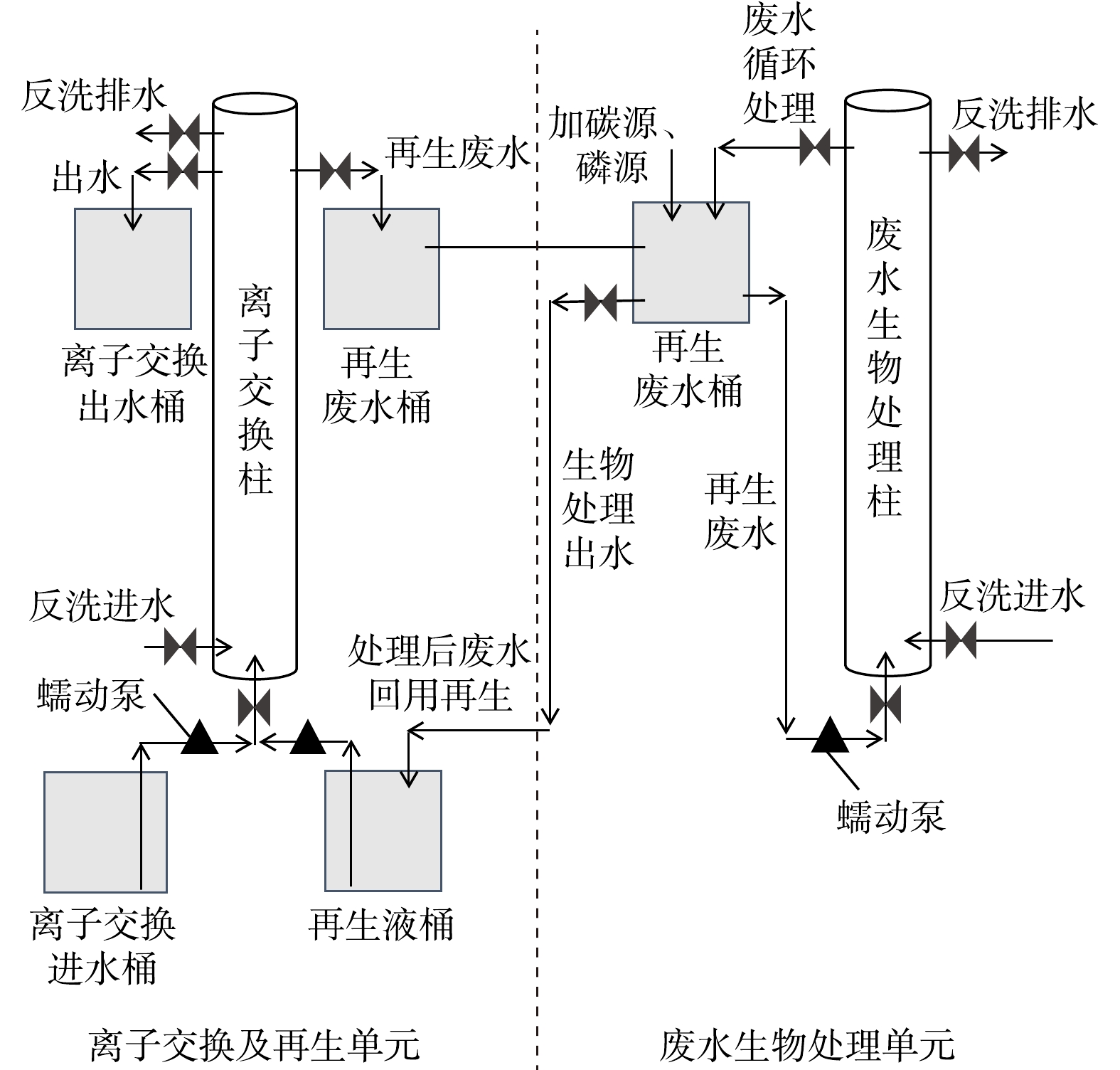
 下载:
下载:
